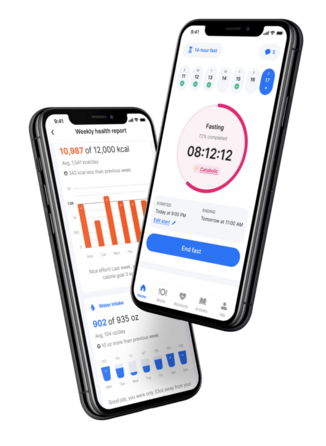Contents
1. Perform Resistance Training
Resistance training is a type of exercise that focuses on building endurance and muscular strength. By building muscle, you can help your body reduce the appearance of loose skin after weight loss by replacing lost fat with increased muscle mass.
Some popular resistance exercises include:
- Bicep curls
- Reverse lunges
- Push-ups
- Sumo squats
- Chest press
- Side lunges
- Crunches
If you are new to resistance training and need guidance, the DoFasting app can be a helpful resource—it offers at-home exercises suitable for beginners and those who don’t enjoy going to the gym, plus an in-house personal trainer that prepares workout routines based on your age, current weight, and fitness level, with options ranging from 6 to 45 minutes. You’ll have plenty of alternatives to start and maintain a routine you can actually stick to.
Take a
1-minute quiz
and discover how much weight you can lose with DoFasting!

2. Take Collagen
Collagen is a protein found in the skin that helps to maintain its structure and elasticity. Some people believe that consuming collagen-rich foods or taking collagen supplements can improve the appearance of loose skin by helping the collagen molecules in your skin grow stronger, although there is limited scientific evidence to support this claim.
Collagen production may be supported by consuming foods that are high in the amino acids that make up collagen, such as:
- Beef bone broth
- Sardines
- Broccoli
- Organ meats
- Berries
- Chicken
- Garlic
- Cashews
However, it’s important to note that the effectiveness of these foods or supplements in improving the appearance of loose skin has not been definitively established.
3. Increase Skin Elasticity With Proper Nutrition
Eating nutrient-dense foods is important to reduce loose skin after weight loss. While a balanced diet alone may not directly target excess skin, the nutrients you consume can help boost collagen production in the long term, which will consequently help tighten excess skin.
Some good options for a balanced diet include:
- Pumpkin seeds
- Cabbage
- Oranges
- Lemons
- Tomatoes
- Cottage cheese
- Bell peppers
- Egg whites
While choosing a balanced diet, it is also important to focus on the right nutrients to stay healthy and help your skin recover—these will be vitamin C, zinc, selenium, and protein, among others. Vitamin C is key for replenishing loose skin, as it strengthens collagen fibers and protects your skin from harmful toxins like free radicals.
For personalized help building a balanced diet, consider seeking advice from DoFasting, where you’ll find 5,000+ recipes chosen by professional nutritionists and resources on maintaining healthy eating.
4. Stay Hydrated
Keeping your skin cells hydrated and plump will improve skin elasticity and prevent it from sagging around your arms, face, and stomach. And you can achieve this by doing something as simple as drinking more water.
Drinking enough water has multiple benefits beyond skin health—it ensures your body is constantly hydrated so it can carry out all its functions correctly, and it is also important for reducing fat cells and promoting significant weight loss results.
The recommended daily water intake is 9 cups for women and 12 cups for men—although this can vary depending on personal factors like your habits or health conditions.
If you’re struggling to reach the minimum recommended amount of water, consider following these tips:
- Set daily goals for yourself — such as aiming to drink a certain number of ounces or cups of water per day.
- Keep a water bottle with you at all times — so you can easily sip on water throughout the day.
- Set reminders on your phone — this can help you remember to drink water at regular intervals.
- Drink water with every meal — as this can help you stay hydrated and also help you feel fuller, which may aid in weight loss.
- Eat water-rich foods — such as fruits and vegetables, which can help contribute to your daily water intake.
- Sip on water constantly — rather than trying to chug large amounts at once.
- Infuse your water with fruit slices or herbs — this will give it a little extra flavor, make it more enjoyable to drink, and ultimately help you stay hydrated.
5. Use Firming Creams
Firming creams can help your body produce more collagen and offer skin-tightening properties, which can be effective in preventing loose skin. However, it’s important to note that these creams won’t remove loose skin once it has already formed. Typically, firming creams contain retinol, a form of vitamin A that increases skin cell production.
While firming creams can help improve the appearance of the skin, it’s important to maintain realistic expectations, as they won’t provide dramatic results or eliminate loose skin completely.
Combining firming creams with a healthy diet, regular exercise, and other anti-aging practices such as sunscreen can help you achieve firmer, more youthful-looking skin. Remember that consistency is key when it comes to seeing results.
Take a
1-minute quiz
and discover how much weight you can lose with DoFasting!

6. Massage Well
Gentle massages can be a helpful method to tighten skin after weight loss. They boost the production of collagen and stimulate blood circulation, which plumps your skin naturally. Even performing a massage twice a day can show noticeable results, making it a worthwhile technique to try.
To perform a massage, use small circular motions on the excess skin. Be careful not to apply too much pressure, as it may cause injury to the skin. For loose skin on the face, move your hands downwards and away from your cheeks.
Using a moisturizer during the massage is also essential to prevent skin dryness. You can use natural oils such as coconut or jojoba oil, or a moisturizer with ingredients like vitamin E and aloe vera to nourish and hydrate the skin.
Keep in mind that massages are only a temporary solution for loose skin. While they may help improve the skin’s appearance in the short term, they won’t necessarily eliminate excess skin. Massages work best in combination with other methods explored in this article, such as building muscle through resistance training and eating a balanced diet.
7. Watch Your Sun Exposure
Too much sun exposure can have a negative impact on your skin’s long-term growth and appearance. UV rays can penetrate collagen fibers and hinder their ability to function correctly, leading to loose skin. So, to tighten loose skin, it’s essential to limit the amount of time you spend in the sun.
Some strategies to avoid sunlight include wearing long-sleeved tops, sunscreen, and hats to cover your scalp. Additionally, staying in the shade on bright days can also help reduce the chances of developing excess skin. These may sound like small actions, but they can really increase your chances of maintaining firm and healthy-looking skin.
8. Take a Sea Salt Bath Every Now and Then
Sea salt is believed to have skin-firming properties that can help prevent sagging. Its high magnesium content can rejuvenate cells and promote skin elasticity. One way to gain the benefits of sea salt is to have a warm sea salt bath 1-2 times a week to keep your skin firm.
In addition to its skin-firming properties, a sea salt bath can also offer several other benefits, as it can:
- Soothe muscle cramps
- Relieve joint pain
- Deeply clean the skin
- Stimulate blood circulation
- Relax your nerves
- Prevent muscle tension
Incorporating sea salt baths into your self-care routine can help you achieve not only firmer skin but also overall physical and mental relaxation.
9. Avoid Smoking for a While
Smoking or inhaling second-hand smoke can damage the building blocks of your skin, which include collagen fibers and elastin. These components are crucial for skin elasticity, and when damaged, they can prevent your skin from shrinking back to normal after losing weight.
To avoid negatively impacting your skin, it’s recommended to quit smoking when attempting to lose weight. Although it may not be an easy process, there are simple things you can do to slowly remove cigarettes from your daily routine, such as exercise, nicotine gum, or self-guided meditation.
By quitting smoking, you can improve the health of your skin and increase your chances of achieving a more toned and youthful appearance.
Can Skin Tighten on Its Own After Weight Loss?
Losing weight slowly can allow your skin to return to normal as your body has time to adjust. Gradually reducing stubborn body fat can help retain more collagen and reduce the chances of developing excess loose skin over time.
Individuals who experience rapid weight loss in a short period of time are more likely to develop loose skin, as their bodies are unable to produce enough collagen to match the rate at which they’re losing weight.
Incorporating natural methods such as those discussed in this article can help prevent sagging skin while you lose weight. And while these methods may not work for everyone, they are definitely worth the try.
Remember that weight loss takes time to become noticeable, and so does the process of removing loose skin. Patience and consistency are key to achieving the results you desire.
Problems That Can Be Caused by Loose Skin
Loose skin after weight loss can lead to certain problems. And although they may not occur for everyone, it’s important to consider them for future reference. If you experience any of them, consult with your doctor to discuss possible medical procedures.
Read on to discover four common problems associated with loose skin after weight loss:
Limited mobility
Saggy skin can impact the way you move and perform day-to-day tasks, which may prevent you from exercising or walking around. If you experience limited mobility as a result of excess skin, speak to a doctor about possible solutions to remove the skin.
Physical discomfort
Excess skin can cause physical discomfort when trying to wear certain clothing or engaging in activities such as long walks, as the skin may rub against other body parts. If this happens, it’s essential to get this skin removed to prevent infections and skin ulcers.
Skin breakdown
Common signs of skin breakdown include purple and red spots. This occurs when the body is unable to push blood into restricted areas, which can lead to tissue death. In the case of loose skin, restricted blood flow can cause it to become black, leathery, and hard to the touch. If you notice any signs of skin breakdown, it’s crucial to seek medical attention immediately to prevent further complications.
Poor body image
If you feel like loose skin could have a negative effect on your self-confidence, know that you’re not alone. The aspect of our skin can have a tremendous impact on our mental well-being. And unfortunately, a poor body image can negatively impact our mental health.
If you think you’re struggling with body image issues, consult with a medical professional about suitable treatments—they can recommend options ranging from medication to talk therapy to help you overcome them.
What Causes Loose Skin After Weight Loss?
Stubborn loose skin after weight loss can have various causes, which may vary depending on your current weight, age, and gender.
Here are some of the main factors that might cause loose skin after weight loss:
- Dehydration — not drinking enough water could prevent the body from releasing toxins, which can accumulate in the skin and damage cells. Staying hydrated by drinking plenty of water throughout the day can help prevent this from happening.
- Genetics — some individuals may have genetic factors that make collagen production less efficient, making it harder to reduce loose skin after weight loss. However, following natural remedies at home can still help them improve skin health.
- Skin aging — as skin naturally ages, it may become more prone to sagging, particularly in older adults who have lost a significant amount of weight. The best way to prevent this is by slowing down weight loss and taking care of the body.
- Poor nutrition — a diet lacking nutrient-dense foods can result in reduced skin elasticity. Eating foods rich in magnesium or potassium can help maintain healthy skin.
- Oxidative stress — Individuals experiencing oxidative stress have an imbalance of antioxidants and free radicals, which can lead to skin cell damage and impact the skin’s appearance. Taking steps to reduce oxidative stress, such as eating a healthy diet and reducing exposure to toxins, can help prevent this from happening.
How Can You Prevent Loose Skin in the First Place?
Yes, there are certain ways you can prevent loose skin during weight loss.
The most crucial factor is to lose weight slowly and gradually, allowing your skin to shrink without damaging elastic fibers. It’s recommended to aim for a weight loss of 1-2 pounds per week, which can help your skin respond accordingly. By taking a gradual approach to weight loss, you can improve your chances of achieving a more toned and youthful appearance.
Some tips to prevent loose skin include:
- Gradual weight loss
- Eating enough nutrients
- Taking collagen supplements
- Staying hydrated
- Avoiding very hot baths
- Building muscle while losing fat
- Avoiding sugary foods
For additional guidance on weight loss, consider using the DoFasting app. This app provides healthy ways to achieve long-term fitness goals, including quick workout routines, nutrient-dense recipes, and personalized weight loss plans.
DoFasting offers tools for safe intermittent fasting, which can help maintain skin health. By setting a fasting window and avoiding food during that time, you can trigger autophagy in the body, a cellular repair process that cleans out damaged cells, including the ones on your skin.
The DoFasting app provides all the educational content needed to maintain healthy skin and improve overall well-being, plus all the tools necessary to achieve your weight loss goals.
Take a
1-minute quiz
and discover how much weight you can lose with DoFasting!

Conclusion
If you’re wondering whether it’s possible to tighten loose skin after weight loss, the answer is yes.
There are various natural methods you can use to reduce loose skin over time. And while it may take some time to see results, it’s important to be patient and consistent. Body contouring surgeries may also be an option to consider if you don’t notice physical changes after all other options have been exhausted.
Before trying any new methods, it’s crucial to consult with your doctor. They can advise you on the best approaches to remove excess skin permanently and help you achieve your desired results safely and effectively. Remember, taking a gradual and steady approach to weight loss and skin tightening can help you achieve the best outcomes.
See how DoFasting will improve your life
Find out what works for you with this 60-sec quiz approved by our experts and get your personal revolutionary fasting assistant.
Start the Quiz
This is an evidence-based article that includes scientific citations. DoFasting’s professional writers and editors prepared the content, which a team of medical experts verified to be accurate.














